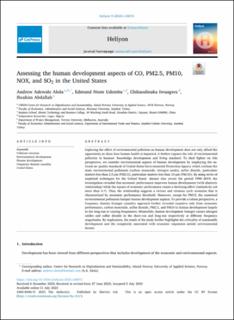| dc.contributor.author | Alola, Andrew Adewale | |
| dc.contributor.author | Udemba, Edmund Ntom | |
| dc.contributor.author | Iwuagwu, Chikaodinaka | |
| dc.contributor.author | Abdallah, Ibrahim | |
| dc.coverage.spatial | USA | en_US |
| dc.date.accessioned | 2023-09-20T08:12:58Z | |
| dc.date.available | 2023-09-20T08:12:58Z | |
| dc.date.created | 2023-09-05T12:17:06Z | |
| dc.date.issued | 2023 | |
| dc.identifier.citation | Heliyon. 2023, 9 (7), . | en_US |
| dc.identifier.issn | 2405-8440 | |
| dc.identifier.uri | https://hdl.handle.net/11250/3090684 | |
| dc.description.abstract | Exploring the effect of environmental pollution on human development does not only afford the opportunity to show how human health is impacted, it further exposes the role of environmental pollution in humans’ knowledge development and living standard. To shed lighter on this perspective, we consider environmental aspects of human development by employing the national air quality standards of United States Environmental Protection Agency which outlines the main environmental pollutants (carbon monoxide, nitrogen oxides, sulfur dioxide, particulate matters less than 2.5 μm (PM2.5), particulate matters less than 10 μm (PM10)). By using series of empirical techniques for the United States’ dataset that covers the period 1990–2019, the investigation revealed that economic performance improves human development (with elasticity relationship) while the square of economic performance causes a declining effect (inelasticity not more than 0.7). Thus, the relationship suggests a vicious and virtuous cycle scenarios that is characterized by economic performance threshold. Moreover, except for PM10, the examined environmental pollutants hamper human development aspects. To provide a robust perspective, a frequency domain Granger causality approach further revealed causative only from economic
performance, carbon monoxide, sulfur dioxide, PM2.5, and PM10 to human development largely
in the long-run at varying frequencies. Meanwhile, human development Granger causes nitrogen
oxides and sulfur dioxide in the short-run and long-run respectively at different frequency magnitudes. By implication, the result of the study further highlights the criticality of sustainable development and the complexity associated with economic expansion amidst environmental factors. | en_US |
| dc.language.iso | eng | en_US |
| dc.rights | Attribution-NonCommercial-NoDerivatives 4.0 Internasjonal | * |
| dc.rights.uri | http://creativecommons.org/licenses/by-nc-nd/4.0/deed.no | * |
| dc.subject | pollutant emission | en_US |
| dc.subject | environmental development | en_US |
| dc.subject | human development | en_US |
| dc.subject | frequency domain causality | en_US |
| dc.subject | USA | en_US |
| dc.title | Assessing the human development aspects of CO, PM2.5, PM10, NOX, and SO<inf>2</inf> in the United States | en_US |
| dc.type | Peer reviewed | en_US |
| dc.type | Journal article | en_US |
| dc.description.version | publishedVersion | en_US |
| dc.rights.holder | © 2023 The Author(s) | en_US |
| dc.subject.nsi | VDP::Samfunnsvitenskap: 200::Økonomi: 210 | en_US |
| dc.source.pagenumber | 15 | en_US |
| dc.source.volume | 9 | en_US |
| dc.source.journal | Heliyon | en_US |
| dc.source.issue | 7 | en_US |
| dc.identifier.doi | 10.1016/j.heliyon.2023.e18072 | |
| dc.identifier.cristin | 2172491 | |
| cristin.ispublished | true | |
| cristin.fulltext | original | |
| cristin.qualitycode | 1 | |

